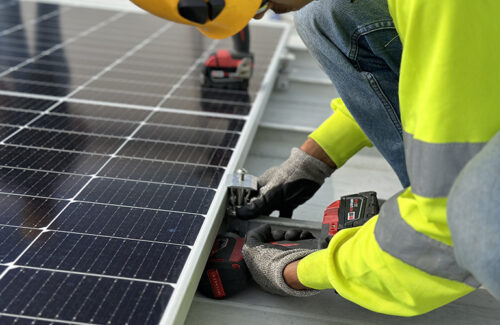The U.S. International Trade Commission today held a midterm hearing on Section 201 tariffs on imported crystalline silicon solar cells and panels (CSPV). Solar imports have been tariffed since 2018, but today’s hearing looked at the latest round initiated by President Joe Biden in 2022.
Traditional, monofacial solar panels imported into the country are currently tariffed at 14.5% through Feb. 6, 2024. The rate is scheduled to drop 0.25% each year through the end-date of Feb. 6, 2026 (14.25% in 2024 and 14% in 2025). Bifacial solar panels are excluded from the tariff. The first 5 GW of imported silicon solar cells to the United States are also excluded from any duties.
Today’s hearing was to see if the tariffs are working in their initial aim to support domestic solar panel manufacturing by preventing cheap solar panels from other countries from being dumped into the market.
Industry advocacy group SEIA participated in the hearing, along with U.S. silicon cell and panel manufacturers Qcells, Canadian Solar, Silfab Solar, Heliene, Suniva and thin-film panel maker First Solar.
First Solar and Suniva stated that the safeguard measures are working as planned and requested no changes. SEIA, Qcells, Canadian Solar, Silfab and Heliene requested the tariff rate quota (TRQ) on imported cells be increased significantly.
The tariff details
A lot has changed since this four-year Section 201 safeguard was initiated by President Biden in February 2022. The extension was requested by U.S. manufacturers Auxin Solar and Suniva, and separately by Hanwha Qcells, LG Electronics and Mission Solar. Since then, LG has stopped making solar panels entirely. Auxin Solar has been quiet since winning its petition for antidumping/countervailing duties (AD/CVD). Qcells is building an ingot/wafer/cell/panel factory in Georgia, Mission Solar is expanding its Texas panel factory and Suniva is finally restarting its own solar cell manufacturing in Georgia — all benefiting from credits offered in the Inflation Reduction Act (IRA).
The IRA passed in August 2022, just six months after the Section 201 tariffs were extended, and provides significant incentives to both solar installers and manufacturers. More manufacturers in the solar panel supply chain are setting up stateside to meet growing domestic demand and to access favorable tax credits. An industry argument is whether tariffing imported solar cells and panels under Section 201 is still necessary to “prop up” the U.S. manufacturing market after getting such a boost from the IRA.
See our list of U.S. solar manufacturers here.
Qcells repeated in its statement to the U.S. ITC that the domestic solar module industry is experiencing improvement as a direct result of the Section 201 tariffs, and that the safeguard measures “saved and created jobs and spurred unprecedented investments in domestic solar manufacturing.” However, the country’s largest silicon solar panel manufacturer did acknowledge that the availability of duty-free cells will soon be insufficient to meet the needs of the expanded U.S. manufacturing market. While the 5-GW quota was adequate before the IRA passed, the increase in module assembly plants in the United States now requires a more substantial TRQ.
Only 2,597 MW of solar cells were imported in 2022, well short of the 5-GW cap. Qcells attributes this to factories being expanded or constructed, and LG closing its doors. “Given the number of new module manufacturing investments being announced and their substantial production capacity, the TRQ will foreseeably exceed its 5 GW limit before, or shortly after, the TRQ resets in February 2024,” Qcells said. As a result, the company is asking for the TRQ to be increased to at least 20 GW.
Canadian Solar, Silfab and Heliene, which jointly testified, also asked for an increase in the TRQ to 20 GW or for the tariffs on imported cells to be removed completely. The trio stated that the TRQ “has no purpose.”
“There is no policy reason for the Administration to impose a safeguard tariff on U.S. module manufacturers. This tariff will only serve to increase U.S. solar manufacturing cost and potentially delay the deployment of U.S. module manufacturing,” they said.
SEIA didn’t suggest a specific number but did ask that the TRQ be raised “significantly.”
“Safeguard measures are intended to ‘facilitate efforts by the domestic industry to make a positive adjustment to import competition and provide greater economic and social benefits than costs,’” SEIA commented. “The current reality is that the U.S. CSPV industry is a module industry. For the industry to grow, it needs access to cells, which must be imported. Imposing restrictions and additional costs on the key input for the U.S. industry defeats, rather than supports, the purposes of the safeguard law.”
On the other side, First Solar isn’t pleased with bifacial’s exemption from the tariffs, but did state that the “safeguard remedy is serving its intended purpose of supporting the domestic industry’s efforts to make a positive adjustment to import competition.” First Solar’s thin-film solar panels are not under the safeguard remedy.
Suniva, which hasn’t produced product in over six years, also supports the Section 201 tariffs continuing as-written. It believes the 5-GW TRQ on imported solar cells is sufficient, as Suniva is so far the only U.S. cell manufacturer not also making its own panels and will potentially have product to sell beginning in April 2024. An increase in the TRQ would not benefit Suniva’s business.
“It is imperative that the TRQ for CSPV cells not be increased further, lest the United States be forever dependent on foreign sources for the heart of solar modules,” Suniva said.
Next steps
Based on the last go-around, the U.S. ITC will release an official midterm report on the tariffs in February 2024. The report is sent to the president and Congress. Only the president can make any legal changes to the in-progress tariff.
In February 2020, the U.S. ITC stated in its midterm report to President Donald Trump only that the industry had seen mixed results from the Section 201 tariffs. Nine months later, the president chose to increase the tariff rate and remove bifacial’s exemption.



















